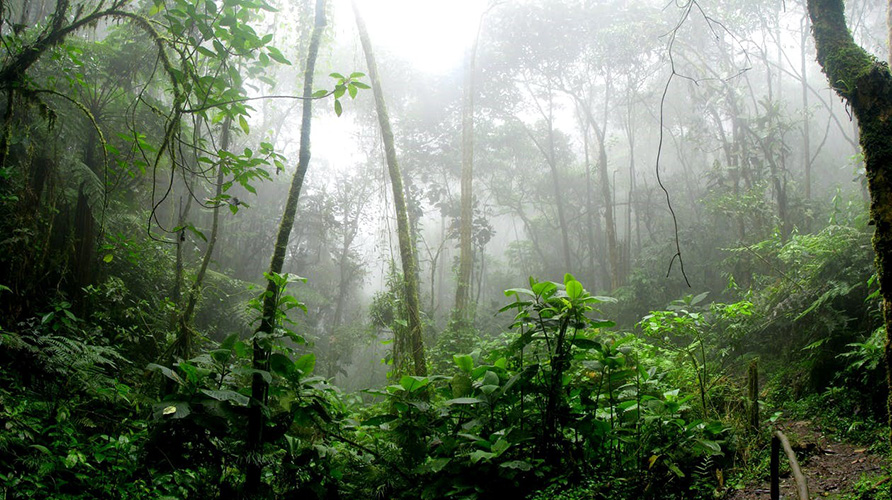Strong Chemical Sources and Sinks Govern Secondary Organic Aerosol Loadings

Simplified representations cannot accurately represent how secondary organic aerosols behave in time and space, limiting their predictive power.
E3SM highlights the importance of chemical sources and sinks of aerosols.
The Science
Secondary organic aerosols (SOAs) formed by the oxidation of carbon-based gases are large contributors to the global mass and number of fine particles. SOAs represent thousands of constantly reacting organic species, which makes predicting their sources and decomposition processes, known as sinks, a key modeling challenge. Most global models use simplified SOA representations that do not accurately capture global SOA budgets and lifetimes. Researchers developed complex but computationally efficient algorithms that can simulate the chemical production and sinks of SOAs within the Energy Exascale Earth System Model (E3SM). Results show that both strong chemical sources, represented by the oxidation of SOA precursor gases, and strong chemical sinks, represented by the photolysis of SOA particles, were needed to explain surface and high-altitude measurements of SOA loadings.
The Impact
The new SOA formulations developed in this study parameterize the chemical complexity of SOAs but are computationally efficient. This makes them practical for their use in predicting SOA distributions in global models like E3SM. These complex treatments produce more accurate results, based on comparisons of model output and global organic aerosol measurements. Accurately representing the connections between SOA formation, natural processes (like biogenic emissions from trees), and human activities (like land-use changes and energy production) are important for understanding how aerosol-cloud and aerosol-radiation interactions have changed since preindustrial times.
Summary

Figure 1. Including particle-phase photolysis of SOAs as a chemical sink is key to bringing E3SM predictions (cyan) into agreement with high altitude aircraft measurements (black) over several regions: Equatorial Ocean, North America, and Southern Ocean. ATom‐1 and ATom‐2 are field campaigns during Jul–Aug 2016 and Jan–Feb 2017, respectively.
Researchers developed and implemented four different model formulations of SOA particles with varying strengths of chemical sources and sinks within E3SM. They compared the predicted global SOA distributions to a suite of organic aerosol measurements from in situ (ground-based and aircraft) and satellite observations. These findings highlight the importance of including complex process-level representation of SOA formation and sinks within global models. The study shows the feasibility of representing chemical complexity while maintaining computational efficiency. All tested formulations needed a strong chemical sink of SOAs, represented by particle-phase photolysis (Fig. 1), to explain the organic aerosol loadings measured by aircraft at high altitudes, i.e., above 6 km. Wet removal sinks are low at high altitudes and above clouds, requiring another strong chemical sink of SOAs, like photolysis, to explain the aircraft observations. This work shows that different SOA chemistry formulations change SOA wet removal lifetimes by a factor of three within the same model physics and cloud representations. This work provides a new framework for representing complex SOA chemistry processes within E3SM in a computationally efficient and more accurate manner. Due to the explicit coupling of SOA precursors and chemical processes with natural and anthropogenic sources, this work provides a baseline for future research aimed at understanding changes in aerosol-cloud and aerosol-radiation interactions from preindustrial times through the future.
Publication
- Lou, S, M Shrivastava, R Easter, Y Yang, P Ma, H Wang, M Cubison, et al. 2020. “New SOA Treatments Within the Energy Exascale Earth System Model (E3SM): Strong Production and Sinks Govern Atmospheric SOA Distributions and Radiative Forcing.” Journal of Advances in Modeling Earth Systems 12(12). https://doi.org/10.1029/2020ms002266.
Funding
- The U.S. Department of Energy Office of Science, Biological and Environmental Research supported this research as part of the Earth System Model Development Program Area through the Energy Exascale Earth System Model (E3SM) project as well as through the DOE Early Career Program.
Contact
- L. Ruby Leung, Pacific Northwest National Laboratory


